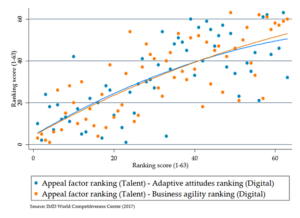
Is the flow of skilled labor related to the agility of an economy?
Reflecting on the popular topics for 2017, two themes stand out among those which captured the interest of researchers and commentators. First, the extent to which economies successfully address the future loss of employment due to the introduction of new technologies; and second, the benefits associated with the general concept of globalization.
In the past editions of this newsletter, we addressed dimensions of both topics separately. The newly launched 2017 IMD World Talent Ranking gives us the opportunity to combine them. In this edition, we will try to explore how the IMD World Competitiveness Dataset can help us relate the attractiveness of an economy to the international pool of talent and the levels of individual adaptive attitudes and business agility.
Attitudes towards changes, both at the individual and at the firm level, affect the adaptation of innovation. At the individual level, the ease by which one can adapt to new environments and become accustomed to new technologies provides an indication of the capacity to successfully adapt to changes within professions. The Adaptive Attitudes sub-factor of the IMD Digital Competitiveness Ranking quantifies this ability.
Similarly, the flexibility and resilience that a firm exhibits towards disruptive changes brought about by new technology and thus the competence to adapt at a business level is reflected in the Business Agility sub-factor of the same ranking.
Within our dataset the level of openness of an economy can be quantified by using either statistical data (e.g. trade to GDP ratio) or survey data (e.g. the perceptions data of managers about the level of protectionism in an economy). An additional way to indirectly measure openness with respect to labor movements is the power of an economy to attract skilled people from the international talent pool. This is captured by the Appeal factor of the IMD World Talent Ranking. Elements related to the quality and cost of living, remuneration and levels of taxation, as well as security and protection of private rights are combined to provide a measure of the Appeal Factor.
The graph below presents the positive relationship between the level of appeal and measures of flexibility both at the individual and business levels. An economy that is characterized by high levels of attractiveness (Appeal) is related to equally high levels of individual adaptability (AdaptiveAttitudes) The correlation coefficient of 0.73 validates this strong positive relationship (the blue line.)
Similarly, the correlation coefficient of 0.77 between the Appeal factor and the Business Agility sub-factor indicated that highly-skilled labor inflow is strongly related with the ability of a firm to cope with technology disruptions (the orange line).
Additional research is needed to carefully examine the causation of this relationship. Nevertheless, this simple graph invites an interesting narrative: highly-skilled migrants bring with them an enhanced level of adaptation and flexibility; or they rapidly integrate into the existent high level of adaptation in their host economy. Furthermore, this enhanced level of flexibility potentially spills over to the aggregate unit of the firm itself. Thus, highly-skilled migrants are also associated with high levels of Business Agility. In sum, flows of highly-skilled labor strengthen an economy by contributing, amongst other things, to a higher degree of flexibility and resilience.
Research Information & Knowledge Hub for additional information on IMD publications
Earlier this month, the European Union began executing its tariffs on China for electric vehicle (EV) imports, yet the dated practice of taxing pro...
The increasing datafication of the workplace is often cast as a means of imposing organisational and managerial control on workers. This reflection...
This paper introduces the New Industrial Policy Observatory (NIPO) data set and documents emergent patterns of policy intervention during 2023 asso...
The payment processing industry in Europe had operated in largely the same way for decades. A standard system of financial processing and clearing ...
Research Information & Knowledge Hub for additional information on IMD publications
Research Information & Knowledge Hub for additional information on IMD publications
Research Information & Knowledge Hub for additional information on IMD publications
Research Information & Knowledge Hub for additional information on IMD publications
in Scandinavian Journal of Information Systems July 2024, vol. 36, no. 1, article 2
Research Information & Knowledge Hub for additional information on IMD publications
in The World Economy July 2024, vol. 47, no. 7, pp. 2762-2788, https://doi.org/10.1111/twec.13608
Research Information & Knowledge Hub for additional information on IMD publications
in I by IMD 27 June 2024
Research Information & Knowledge Hub for additional information on IMD publications
Research Information & Knowledge Hub for additional information on IMD publications
Research Information & Knowledge Hub for additional information on IMD publications
Research Information & Knowledge Hub for additional information on IMD publications






